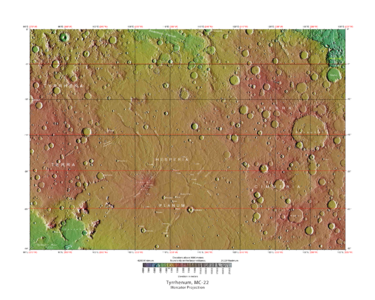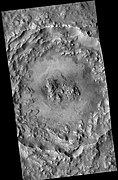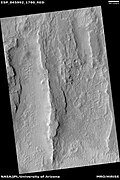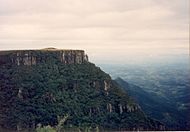The Mare Tyrrhenum quadrangle contains a rich variety of features that include one of the planet’s oldest volcanoes, and many of the usual beautiful landscapes on the planet such as columnar jointing, craters, dunes, ridge networks, and even a landslide.
Geography and origin of name
Most of the region contains heavily cratered highlands. The central part contains Tyrrhena Patera (a very old volcano). The Mare Tyrrhenum quadrangle encompasses parts of the regions Tyrrhena Terra, Hesperia Planum, and Terra Cimmeria. Mare Tyrrhenum's largest crater is Herschel. Licus Vallis and the Ausonia Montes are other major features in the region.
The Mare Tyrrhenum quadrangle is one of a series of 30 quadrangle maps of Mars used by the United States Geological Survey (USGS). This quadrangle is also referred to as MC-22 (Mars Chart-22).[1]
This quadrangle covers the area from 0° to 30° south latitude and 225° to 270° west longitude (135-90 E). Giovanni Schiaparelli named the area after Earth's Tyrrhenian Sea, which lies between Italy and Sicily. The region was subsequently renamed to Mare Tyrrhena after spacecraft photos revealed that it is an old, cratered plain rather than a sea.[2] [3]
Importance of craters
The density of impact craters is used to determine the surface ages of Mars and other solar system bodies.[4] The older the surface, the more craters present. Crater shapes can reveal the presence of ground ice. The Mare Tyrrhenum quadrangle lies in the southern hemisphere—an old region with many craters.
The area around craters may be rich in minerals. On Mars, heat from the impact melts ice in the ground. Water from the melting ice dissolves minerals, and then deposits them in cracks or faults that were produced with the impact. This process, called hydrothermal alteration, is a major way in which ore deposits are produced. The area around Martian craters may be rich in useful ores for the future colonization of Mars.[5]
Depression on crater floor, as seen by HiRISE under HiWish program. This scene is enlarged in the next two images.
Close-up of depression on crater floor, as seen by HiRISE under HiWish program.
Close-up of west edge of crater depression, as seen by HiRISE under HiWish program.
Dunes in crater, as seen by HiRISE under HiWish program. Some of these dunes are Barchans.
Dunes among craters, as seen by HiRISE under HiWish program. Some of these dunes are Barchans
Hydrothermal features in Auki
The crater Auki shows ridge networks that some researchers believe to be evidence of hydrothermal processes that occurred after impact. Impacts fracture rock and create enormous amounts of heat. On Mars, this heat can cause ice to melt and then the resulting water to move through cracks that are generated during impact. This water will eventually deposit minerals. The mineral deposits may become evident when surrounding ground erodes. Deposits formed in this manner are more resistant to erosion.
Researchers have speculated that these hydrothermal effects should be common on Mars.[6] Ridges found in and around the center of Auki are evidence. This crater contains ridges that may have been produced after fractures formed with an impact. Using instruments on the Mars Reconnaissance Orbiter they found the minerals smectite (clay), silica, zeolite, serpentine, carbonate, and chlorite that are common in impact-induced hydrothermal systems on Earth.[7] [8] [9] [10] [11] [12] Evidence of other hydrothermal systems around craters other than Auki has been found by different groups of scientists.[13] [14] [15]
Topographical map showing location of Auki crater and other nearby features. Color shows elevation.
Wide view of Auki, as seen by CTX
Close view of central portion of Auki, as seen by HiRISE Arrow indicates ridges. Sand dunes are present near the top of the image.
Close view of ridges from previous HiRISE image Arrow indicates an "X" shaped ridge.
Close view of central section of Auki showing ridges with arrow Image is an enlargement of a previous HiRISE image.
Channels
There is enormous evidence that water once flowed in river valleys and channels on Mars. Images of curved channels have been seen in images from Mars spacecraft dating back to the early seventies with the Mariner 9 orbiter.[16] [17] [18] [19]
Vallis (plural valles) is the Latin word for 'valley. It is used in planetary geology for the naming of features on other planets, including what could be old river valleys that were discovered on Mars, when probes were first sent to Mars. The Viking Orbiters caused a revolution in our ideas about water on Mars; river valleys were found in many areas. Space craft cameras showed that floods of water broke through dams, carved deep valleys, eroded grooves into bedrock, and traveled thousands of kilometers.[20] [21] Cite error: Closing </ref> missing for <ref> tag Ridges often appear as mostly straight segments that intersect in a lattice-like manner. They are hundreds of meters long, tens of meters high, and several meters wide. Scientists are not totally sure what caused these ridges, but one popular idea is that impacts created fractures in the surface, these fractures later acted as channels for fluids. Fluids cemented the structures. With the passage of time, surrounding material was eroded away, thereby leaving hard ridges behind.
Since the ridges occur in locations with clay, these formations could serve as a marker for past water because clay requires water to be made.[22] [23] [24] Water here could have supported past life in these locations. Clay may also preserve fossils or other traces of past life.
Linear ridge network, as seen by HiRISE under HiWish program
Wide view of several groups of linear ridges, as seen by HiRISE under HiWish program
Close view of curved ridges, as seen by HiRISE under HiWish program Note: this is an enlargement of previous image.
Close view of ridges, from a previous image, as seen by HiRISE under HiWish program
Close view of ridges, from a previous image, as seen by HiRISE under HiWish program Arrows indicate fractures in ridge
Blocks probably formed after fracturing in ridges Image, as seen by HiRISE under HiWish program
Wide view of ridge networks, as seen by HiRISE under HiWish program Parts of this are enlarged in next three images.
Close view of ridge networks, as seen by HiRISE under HiWish program
Close view of ridge networks, as seen by HiRISE under HiWish program
Close view of ridge networks, as seen by HiRISE under HiWish program Since some ridges are at the bottom of the depression, the ridges may be from a lower layer.
Dunes
Sand dunes have been found in many places on Mars. They are usually in low spots—like crater floors. In HiRISE images they can appear in a variety of pretty colors. The colors are somewhat artificial. NASA uses the colors to determine mineral composition. The presence of dunes shows that the planet has an atmosphere with wind, for dunes require wind to pile up the sand. Most dunes on Mars are black because of the weathering of the volcanic rock basalt.[25] [26] Black sand can be found on Earth on Hawaii and on some tropical South Pacific islands.[27]
Sand is common on Mars due to the old age of the surface that has allowed rocks to erode into sand. Dunes on Mars have been observed to move many meters.[28] [29] [30]
Some dunes move along. In this process, sand moves up the windward side and then falls down the leeward side of the dune, thus caused the dune to go toward the leeward side (or slip face).[31] When iimages are enlarged, some dunes on Mars display ripples on their surfaces.Cite error: Closing </ref> missing for <ref> tag
Wide view of layered features, as seen by HiRISE under HiWish program
Layered features, as seen by HiRISE under HiWish program
Layered features, as seen by HiRISE under HiWish program Arrows show where some layers are.
Layered features, as seen by HiRISE under HiWish program
Layers in crater wall, as seen by HiRISE under HiWish program
Layers, as seen by HiRISE under HiWish program
Columnar Jointing
Lava flows sometimes cool to form large groups of more-or-less equally sized columns.[32] [33] These joints have been seen on Mars.[34]
Wide view of crater that has columnar jointing that is visible in enlarged images that follow Picture taken with HiRISE.
Crater wall with columnar jointing in the location of the box Columnar joints are easily seen in the enlarged image that follows. Picture taken with HiRISE.
Close view of crater wall with columnar jointing labeled Picture taken with HiRISE.
Columnar jointing on the Earth.
Columnar jointing on the Earth.
Other views in Mare Tyrrhenum quadrangle
Tyrrhenus Mons, as seen by HiRISE and suggested by Ehsan Sanaei's high school astronomy club in Yazd, Iran. Click on image to see excellent view of pit crater chains and concentric features around a volcano.
Wide view of ridges that are mostly curved. Picture taken with HiRISE under HiWish program
Mostly curved ridges Picture taken with HiRISE under HiWish program
Ridges of different sizes, some indicated by arrows are straight. Picture taken with HiRISE under HiWish program
Mostly curved ridges Picture taken with HiRISE under HiWish program
Ridges, some of which seem to have layers Picture taken with HiRISE under HiWish program
Wide view of linear features, as seen by HiRISE under HiWish program
Close view of linear features, as seen by HiRISE under HiWish program
Close, color view of linear features, as seen by HiRISE under HiWish program
Landslide, as seen by HiRISE under HiWish program
Crater, as seen by HiRISE under HiWish program The floor appears to have dropped some.
Ejecta lobes in a crater, as seen by HiRISE under HiWish program
Fractured crater floor, as seen by HiRISE under HiWish program
See also
References
Further reading
- Lorenz, R. 2014. The Dune Whisperers. The Planetary Report: 34, 1, 8-14
- Lorenz, R., J. Zimbelman. 2014. Dune Worlds: How Windblown Sand Shapes Planetary Landscapes. Springer Praxis Books / Geophysical Sciences.
External links
- High resolution video by Seán Doran of overflight of part of north central Mare Tyrrhenum quadrangle, including Tinto Vallis and Amenthes Planum (continues across the equator into Amenthes quadrangle)
↑ Davies, M.E.; Batson, R.M.; Wu, S.S.C. “Geodesy and Cartography” in Kieffer, H.H.; Jakosky, B.M.; Snyder, C.W.; Matthews, M.S., Eds. Mars. University of Arizona Press: Tucson, 1992.
↑ Hartmann, W. 2003. A Traveler's Guide to Mars. Workman Publishing. NY NY.
↑ Carr, M. 2007. The surface of Mars. Cambridge University Press. New York.
↑ http://www.lpi.usra.edu/publications/slidesets/stones/
↑ http://www.indiana.edu/~sierra/papers/2003/Patterson.html.
↑ Osinski, G., et al. 2013. Impact-generated hydrothermal systems on Earth and Mars. Icarus: 224, 347-363.
↑ Carrozzo, F. et al. 2017. Geology and mineralogy of the Auki Crater, Tyrrhena Terra, Mars: A possible post impact-induced hydrothermal system. 281: 228-239
↑ Loizeau, D. et al. 2012. Characterization of hydrated silicate-bearing outcrops in tyrrhena Terra, Mars: implications to the alteration history of Mars. Icarus: 219, 476-497.
↑ Naumov, M. 2005. Principal features of impact-generated hydrothermal circulation systems: mineralogical and geochemical evidence. Geofluids: 5, 165-184.
↑ Ehlmann, B., et al. 2011. Evidence for low-grade metamorphism, hydrothermal alteration, and diagenesis on Mars from phyllosilicate mineral assemblages. Clays Clay Miner: 59, 359-377.
↑ Osinski, G. et al. 2013. Impact-generated hydrothermal systems on Earth and Mars. Icarus: 224, 347-363.
↑ Schwenzer, S., D. Kring. 2013. Alteration minerals in impact-generated hydrothermal systems – Exploring host rock variability. Icarus: 226, 487-496.
↑ Marzo, G., et al. 2010. Evidence for hesperian impact-induced hydrothermalism on Mars. Icarus: 667-683.
↑ Mangold, N., et al. 2012. Hydrothermal alteration in a late hesperian impact crater on Mars. 43rd Lunar and Planetary Science. #1209.
↑ Tornabene, L., et al. 2009. Parautochthonous megabreccias and possible evidence of impact-induced hydrothermal alteration in holden crater, Mars. 40th LPSC. #1766.
↑ Baker, V. 1982. The Channels of Mars. Univ. of Tex. Press, Austin, TX
↑ Baker, V., R. Strom, R., V. Gulick, J. Kargel, G. Komatsu, V. Kale. 1991. Ancient oceans, ice sheets and the hydrological cycle on Mars. Nature 352, 589–594.
↑ Carr, M. 1979. Formation of Martian flood features by release of water from confined aquifers. J. Geophys. Res. 84, 2995–300.
↑ Komar, P. 1979. Comparisons of the hydraulics of water flows in Martian outflow channels with flows of similar scale on Earth. Icarus 37, 156–181.
↑ Kieffer|title=Mars|url=https://books.google.com/books?id=NoDvAAAAMAAJ%7Caccessdate=7 March 2011|date=1992|publisher=University of Arizona Press|isbn=978-0-8165-1257-7
↑ Raeburn, P. 1998. Uncovering the Secrets of the Red Planet Mars. National Geographic Society. Washington D.C.
↑ Mangold et al. 2007. Mineralogy of the Nili Fossae region with OMEGA/Mars Express data: 2. Aqueous alteration of the crust. J. Geophys. Res., 112, doi:10.1029/2006JE002835.
↑ Mustard et al., 2007. Mineralogy of the Nili Fossae region with OMEGA/Mars Express data: 1. Ancient impact melt in the Isidis Basin and implications for the transition from the Noachian to Hesperian, J. Geophys. Res., 112.
↑ Mustard et al., 2009. Composition, Morphology, and Stratigraphy of Noachian Crust around the Isidis Basin, J. Geophys. Res., 114, doi:10.1029/2009JE003349.
↑ http://hirise.lpl.arizona.edu/ESP_016459_1830
↑ Michael H. Carr|title=The surface of Mars|url=https://books.google.com/books?id=uLHlJ6sjohwC%7Caccessdate=21 March 2011|year=2006|publisher=Cambridge University Press|
↑ https://www.desertusa.com/desert-activity/sand-dune-wind1.html
↑ https://www.youtube.com/watch?v=ur_TeOs3S64
↑ https://uanews.arizona.edu/story/the-flowing-sands-of-mars
↑ Cardinale, M., S. Silvestro, D. Vazd, T. Michaels, M. Bourke, G. Komatsu, L. Marinangeli. 2016. Present-day aeolian activity in Herschel Crater, Mars. Icarus: 265, 139-148.
↑ Namowitz, S., Stone, D. 1975. earth science the world we live in. American Book Company. New York.
↑ http://volcano.oregonstate.edu/columnar-jointing
↑ Bates, R. and J. Jackson (eds.) 1976. Dictionary of Geological Terms. Doubleday, New York.
↑ McEwen, A. et al. 2017. Mars The Pristine Beauty of the Red Planet. University of Arizona Press. Tucson.























































